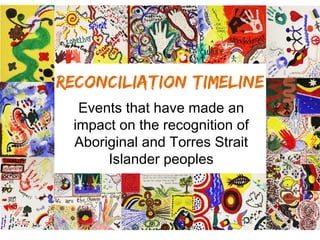
National Reconciliation Week 2012 - timeline of reconciliation events
- 1. Reconciliation timeline Events that have made an impact on the recognition of Aboriginal and Torres Strait Islander peoples
- 3. 1770 – Captain Cook enters Botany Bay on the Endeavour. The British Government does not recognise the rights of Aboriginal and Torres Strait Islander peoples and their special connection with the land. Instead – they declare Australia is terra nullius – land belonging to nobody
- 4. 1778 – The First Fleet arrives and builds a settlement at Port Jackson in Sydney, New South Wales
- 5. 1778 – The First Fleet arrives and builds a settlement at Port Jackson in Sydney, New South Wales
- 7. Contact art depicts these early encounters
- 8. Contact art depicts these early encounters
- 10. 1901 - the Commonwealth of Australia is formed. The constitution is enacted and the first federal parliament sits.
- 13. 1948 – New federal legislation gives the category of ‘Australian Citizenship’ to all Australians, including Aboriginal and Torres Strait Islanders, for the first time At a state level, however, Aboriginal and Torres Strait Islander peoples still suffer legal discrimination.
- 14. 1962 – The Commonwealth Electoral Act is amended to give the vote to all Aboriginal and Torres Strait Islander peoples at Federal Elections
- 15. 1967 – On May 27, more than 90 per cent of Australians vote ‘YES’ in a referendum to give the Australian Government the power to make laws for Aboriginal and Torres Strait Islander peoples
- 19. 1972 – The Aboriginal Tent Embassy is pitched outside Parliament House in Canberra, campaigning for the recognition of Aboriginal land rights
- 20. The embassy commemorated its 40th anniversary this year
- 21. The embassy commemorated its 40th anniversary this year
- 24. 1985 – Uluru is handed back to its traditional owners in a ceremony at the base of the rock
- 27. 1988 – The Barunga Statement, calling for rights for Aboriginal and Torres Strait Islander peoples, is presented to Prime Minister Bob Hawke
- 29. 1991 – The Royal Commission into Black Deaths in Custody presents its final report into the deaths of 99 Aboriginal and Torres Strait Islander people in Australian jails
- 30. 1991 – The Royal Commission into Black Deaths in Custody presents its final report into the deaths of 99 Aboriginal and Torres Strait Islander people in Australian jails
- 32. 1992 – On June 3, The high Court hands down the Mabo decision, recognising the special relationship that Aboriginal and Torres Strait Islander peoples have with the land
- 34. In this decision, the Court rules that Australia was never terra nullius
- 35. 1993 – The United Nations declares 1993 the International Year of the World’s Indigenous People
- 36. Prime Minister Paul Keating launches Australia's celebrations of the 1993 International Year of the World's Indigenous Peoples, giving an historic speech at Redfern
- 37. 1996 – The Council for Aboriginal Reconciliation launches Australia’s first National Reconciliation Week
- 38. 1996 – The Council for Aboriginal Reconciliation launches Australia’s first National Reconciliation Week
- 39. 1996 – The Council for Aboriginal Reconciliation launches Australia’s first National Reconciliation Week
- 40. 1997 – The Bringing Them Home report on Australia’s Stolen Generations is launched at the National Reconciliation Conference Between 1910 and 1970, 20,000 to 25,000 Aboriginal and Torres Strait Islander children were removed from their families and communities by the Australian Government against the will of their parents. The effects of these forced removal policies include broken families, diminished physical and mental health, loss of language, culture and connection to traditional land, loss of parenting skills and enormous distress continuing today. Not one Aboriginal family escaped the effects of the forced removal policies. Intergenerational effects are prevalent today.
- 44. Cover image of the Bringing Them Home report
- 45. 1998 – on 26 May, the first National Sorry Day is commemorated, as recommended by the Bringing Them Home report
- 49. 2000 – Reconciliation Australia is established
- 50. 2000 – In May, approximately 300,000 people walk across Sydney Harbour Bridge as part of National Reconciliation Week, showing support for the reconciliation process
- 51. 2000 – In May, approximately 300,000 people walk across Sydney Harbour Bridge as part of National Reconciliation Week, showing support for the reconciliation process
- 52. 2004 – The Commonwealth Government established a memorial to the Stolen Generations at Reconciliation Place in Canberra
- 53. 2007 – As Australia celebrates the 40th anniversary of the 1967 referendum, Prime Minister John Howard begins an intervention into Northern Territory Aboriginal Communities
- 54. 2007 – As Australia celebrates the 40th anniversary of the 1967 referendum, Prime Minister John Howard begins an intervention into Northern Territory Aboriginal Communities
- 55. 2007 – As Australia celebrates the 40th anniversary of the 1967 referendum, Prime Minister John Howard begins an intervention into Northern Territory Aboriginal Communities
- 56. 2007 – As Australia celebrates the 40th anniversary of the 1967 referendum, Prime Minister John Howard begins an intervention into Northern Territory Aboriginal Communities
- 57. 2008 – Prime Minister Kevin Rudd formally apologises to the Stolen Generations on behalf of the Australian Parliament
- 58. 2008 – Prime Minister Kevin Rudd formally apologises to the Stolen Generations on behalf of the Australian Parliament
- 59. 2008 – Prime Minister Kevin Rudd formally apologises to the Stolen Generations on behalf of the Australian Parliament
- 61. 2012 onward – what future steps do you think Australia should take towards greater recognition of Aboriginal and Torres Strait Islander peoples?
- 62. Did you know – 82% of Australians want to recognise Aboriginal and Torres Strait Islander peoples in the Australian Constitution. It’s time to create a nation for us all.
